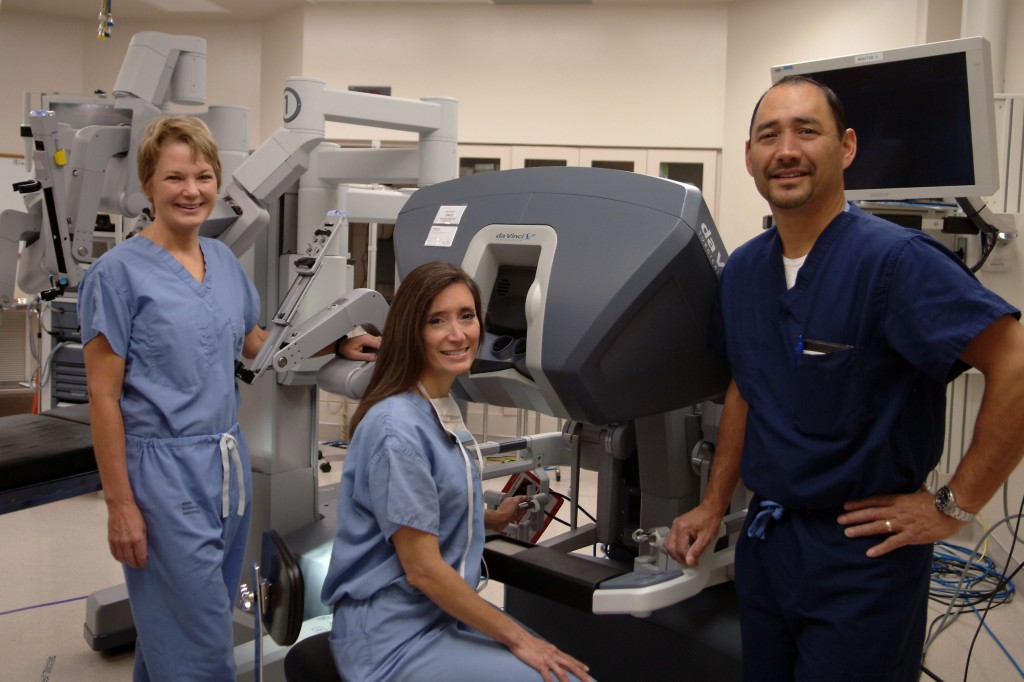I need a hysterectomy. Should I ask my Doctor about robotic surgery?
Dr. Gwen Jonas – November 2013
To answer this question, let’s first review what exactly is entailed in your surgery, the methods by which it could be done and talk about the benefits of Minimally Invasive Surgery. We will then cover how Robotic-assisted surgery allows some women to have Minimally Invasive Surgery who otherwise might not have been good candidates. Hopefully, this will help you to decide if this is an approach you should consider with your surgeon.
Hysterectomy is the removal of the uterus with or without cervix, tubes and ovaries. It is most often recommended for pain, heavy bleeding, or precancerous or cancerous lesions. This has traditionally been done through a large incision in the abdomen, through the vagina, or through the vagina with the help of laparoscope (a telescope placed through the belly button). Minimally Invasive Surgery refers to techniques of surgery that are specifically done through very small incisions so as to result in less scarring, less pain and a quicker recovery. This has until now included Vaginal Hysterectomy or Laparoscopic-Assisted Hysterectomy. Robotic-assisted Laparoscopic Hysterectomy is the newest approach to minimally invasive gynecologic surgery. It refers to using a computer to assist the surgeon in performing the hysterectomy.
Robotic-assistance is a revolutionary surgical technology designed to help surgeons perform many different minimally invasive surgeries more easily. It allows 3-D, magnified visualization of the surgical field and allows the surgeon to feel as though they are inside the body looking at the anatomy from a new perspective. The instruments are extremely small and, unlike previous rigid, straight surgical instruments, they work like a surgeon’s own wrist – bending in multiple directions at the tip. Because most of the movement occurs at the end of the instruments, there is very little trauma to the abdominal wall at the incision sites.
The robotic technology also smoothes the surgeon’s movements by removing human tremor. The “robot” is a computer assistant to the surgeon; it cannot operate by itself. The surgeon uses it to offer her or his patients minimally invasive surgery in a greater number of situations. In the past, women who had a very large uterus, a great deal of scarring, severe endometriosis or cancer might not be candidates for a vaginal or laparoscopic approach to their surgery. Robotic surgery allows them the same options as women without these issues. In addition, it is used in many women when one or more of these issues is suspected and might result in the need to “convert” a vaginal or laparoscopic surgery to and open surgery in the middle of the case.
Why is this important?
A great deal of the pain of surgery arises from the incision on the outside of the body. The incision size for a traditional or open hysterectomy is approximately 6 inches, and may be 12 or more inches in cases of cancer. In laparoscopic or robotic-assisted laparoscopic hysterectomy this is generally decreased to several much smaller incisions that total less than 2 inches, the largest being generally just shy of ½ inch. This translates to much smaller scars and less pain.
In addition, minimally invasive surgical techniques allow less tissue trauma surrounding the surgical site because instruments are smaller and more precise. This results in less pain, blood loss, and theoretically, less scarring inside the body. The robotic approach also allows the surgeon to see better in the deep areas of the abdomen and pelvis than was possible with traditional open surgery.
In all cases, seeing better is well… better.
Since, it was first introduced for gynecologic surgeries in 2005, the use of Robotic assistance has grown drastically. Some studies show that nearly 40% of all hysterectomies done in the US are now done with robotic assistance. At the same time, the number of open hysterectomies has dropped correspondingly from 60% to 30%. This means that many more women are benefiting from Minimally Invasive Surgery.
This all sounds great. So is there a down side?
Inside the field of medicine there are controversies surrounding this new technology. As you might imagine, a “Robot” is expensive. The instruments that are utilized with the robot are also expensive, although in many cases, the cost is similar to those used in simple laparoscopic surgery. At a time when Physicians are trying to cut costs in every way possible, any potential added expense is frowned upon. The present studies comparing robotic-assisted surgery to laparoscopic surgery have not shown huge improvements in things like blood loss or time in the hospital. But to be fair, both of those things were very low in laparoscopic surgery already.
As we have more experience with robotic-assisted surgeries, surgeons are becoming more efficient, often bringing the cost of these surgeries on par with more standard approaches. We should remember that women who would have had a large, open incision and now can have minimally invasive surgery do benefit greatly from less medication, shorter hospital stay and a more rapid return to work. This is an overall economic benefit to the patient. However, it is fair to ask your surgeon, insurance company or hospital if you can expect a larger bill if you have robotic surgery.
Initially, I was skeptical of robotic-assisted gynecology. Once I began performing robotic-assisted surgeries I became convinced of the advantages. My personal experience as a surgeon is that the majority of my patients use significantly less pain medication afterwards, and feel great sooner than those who have other methods of hysterectomy.
But while Robotic-assisted laparoscopic surgery offers advantages in gynecologic surgery, it is not necessary or appropriate for all cases.
It is not needed for simple intra-abdominal surgeries like tubal ligations or vaginal surgeries for removal of precancerous cervical tissue for instance. If your surgeon is planning a vaginal or laparoscopic approach already, it may not be of benefit. However, if it has been recommended either that you have a large open incision for your surgery, or if you have been warned that there is a high likelihood that plans may be changed while you are asleep to include a large open incision, it is appropriate to ask if robotic assistance is available. If the answer is no, and you are concerned, consider asking for a second opinion.
As a surgeon, I always want my patients to feel comfortable with the decisions surrounding surgery. If a second opinion helps my patient feel good about her decision, I am very supportive of her seeking that opinion. But remember, even in Robotic-assisted surgeries, there may be times, although rare, when an open incision is the safest approach for the patient. Having a surgeon who is experienced with all approaches is wise.
Your relationship with your surgeon is very important. You should feel comfortable asking questions. You should also feel comfortable that all of your options for treatment, the reasons you need surgery, and all surgical approaches have been thoroughly discussed.
::::::::::::::::::::::::::::::::::::::::::::::::::::::::::::::::::::::::::::::::::::::::::::::::::::::::::::::::::::::::::::::::::::::::::::::::::::::::::::::::::::::::::::::::::::::::::::::::::::::::::::
 Author: Dr. Gwen Jonas – Kalispell OB/GYN Associates
Author: Dr. Gwen Jonas – Kalispell OB/GYN Associates
Dr. Jonas is a regular contributor on women’s health articles at 406 Woman Magazine
PLEASE NOTE: This information is not intended to be medical advice. It is general health information and does not take into account your particular health status nor is it a substitute for personal medical care. Kalispell OB/GYN shall not be liable for any damages arising out of the use of the content herein.

